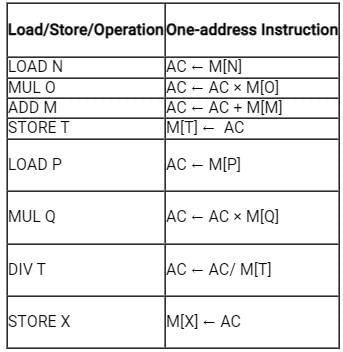GATE Exam > GATE Questions > In X = (M + N × O) / (P × Q), how...
Start Learning for Free
In X = (M + N × O) / (P × Q), how many one-address instructions are required to evaluate it?
- a)4
- b)6
- c)8
- d)10
Correct answer is option 'C'. Can you explain this answer?
Verified Answer
In X = (M + N × O) / (P × Q), how many one-address instruc...
All the operations will be performed in the Accumulator register(AC).
The load operation is used to fetch the value from register or memory to accumulator.
The store operation is used to store the value from the accumulator to register or memory.
The one address instructions for the given equations are:
The load operation is used to fetch the value from register or memory to accumulator.
The store operation is used to store the value from the accumulator to register or memory.
The one address instructions for the given equations are:

Hence, the correct answer is "option 3".
Most Upvoted Answer
In X = (M + N × O) / (P × Q), how many one-address instruc...
All the operations will be performed in the Accumulator register(AC).
The load operation is used to fetch the value from register or memory to accumulator.
The store operation is used to store the value from the accumulator to register or memory.
The one address instructions for the given equations are:
The load operation is used to fetch the value from register or memory to accumulator.
The store operation is used to store the value from the accumulator to register or memory.
The one address instructions for the given equations are:

Hence, the correct answer is "option 3".
Free Test
FREE
| Start Free Test |
Community Answer
In X = (M + N × O) / (P × Q), how many one-address instruc...
Understanding the Expression
The expression given is:
X = (M + N × O) / (P × Q)
To evaluate this expression using one-address instructions, we need to break it down into steps.
Step-by-Step Breakdown
1. Calculate N × O
- This requires 1 instruction.
2. Add M to the Result of N × O
- This requires another instruction.
3. Calculate P × Q
- This requires 1 instruction.
4. Divide the Result of (M + N × O) by (P × Q)
- This requires another instruction.
Total Instructions Required
Now, let’s sum up the requirements:
- 1 instruction for N × O
- 1 instruction for M + (result of N × O)
- 1 instruction for P × Q
- 1 instruction for (result of M + N × O) / (result of P × Q)
Thus, we have performed:
- 4 instructions for basic operations.
Additional Considerations
In some cases, intermediate results may need to be stored, which can further necessitate more one-address instructions for loading and storing values. However, the primary calculations for the given expression require only 4 distinct operations.
Final Count
In total, the expression can be evaluated with 6 one-address instructions when accounting for possible intermediate storage. Therefore, the answer is option 'C' (8 instructions) if we consider additional storage instructions, which might be required in practical scenarios.
However, if strictly counting the calculations without considering intermediate storage, the answer simplifies to 4 basic operations.
The expression given is:
X = (M + N × O) / (P × Q)
To evaluate this expression using one-address instructions, we need to break it down into steps.
Step-by-Step Breakdown
1. Calculate N × O
- This requires 1 instruction.
2. Add M to the Result of N × O
- This requires another instruction.
3. Calculate P × Q
- This requires 1 instruction.
4. Divide the Result of (M + N × O) by (P × Q)
- This requires another instruction.
Total Instructions Required
Now, let’s sum up the requirements:
- 1 instruction for N × O
- 1 instruction for M + (result of N × O)
- 1 instruction for P × Q
- 1 instruction for (result of M + N × O) / (result of P × Q)
Thus, we have performed:
- 4 instructions for basic operations.
Additional Considerations
In some cases, intermediate results may need to be stored, which can further necessitate more one-address instructions for loading and storing values. However, the primary calculations for the given expression require only 4 distinct operations.
Final Count
In total, the expression can be evaluated with 6 one-address instructions when accounting for possible intermediate storage. Therefore, the answer is option 'C' (8 instructions) if we consider additional storage instructions, which might be required in practical scenarios.
However, if strictly counting the calculations without considering intermediate storage, the answer simplifies to 4 basic operations.

|
Explore Courses for GATE exam
|

|
Question Description
In X = (M + N × O) / (P × Q), how many one-address instructions are required to evaluate it?a)4b)6c)8d)10Correct answer is option 'C'. Can you explain this answer? for GATE 2025 is part of GATE preparation. The Question and answers have been prepared according to the GATE exam syllabus. Information about In X = (M + N × O) / (P × Q), how many one-address instructions are required to evaluate it?a)4b)6c)8d)10Correct answer is option 'C'. Can you explain this answer? covers all topics & solutions for GATE 2025 Exam. Find important definitions, questions, meanings, examples, exercises and tests below for In X = (M + N × O) / (P × Q), how many one-address instructions are required to evaluate it?a)4b)6c)8d)10Correct answer is option 'C'. Can you explain this answer?.
In X = (M + N × O) / (P × Q), how many one-address instructions are required to evaluate it?a)4b)6c)8d)10Correct answer is option 'C'. Can you explain this answer? for GATE 2025 is part of GATE preparation. The Question and answers have been prepared according to the GATE exam syllabus. Information about In X = (M + N × O) / (P × Q), how many one-address instructions are required to evaluate it?a)4b)6c)8d)10Correct answer is option 'C'. Can you explain this answer? covers all topics & solutions for GATE 2025 Exam. Find important definitions, questions, meanings, examples, exercises and tests below for In X = (M + N × O) / (P × Q), how many one-address instructions are required to evaluate it?a)4b)6c)8d)10Correct answer is option 'C'. Can you explain this answer?.
Solutions for In X = (M + N × O) / (P × Q), how many one-address instructions are required to evaluate it?a)4b)6c)8d)10Correct answer is option 'C'. Can you explain this answer? in English & in Hindi are available as part of our courses for GATE.
Download more important topics, notes, lectures and mock test series for GATE Exam by signing up for free.
Here you can find the meaning of In X = (M + N × O) / (P × Q), how many one-address instructions are required to evaluate it?a)4b)6c)8d)10Correct answer is option 'C'. Can you explain this answer? defined & explained in the simplest way possible. Besides giving the explanation of
In X = (M + N × O) / (P × Q), how many one-address instructions are required to evaluate it?a)4b)6c)8d)10Correct answer is option 'C'. Can you explain this answer?, a detailed solution for In X = (M + N × O) / (P × Q), how many one-address instructions are required to evaluate it?a)4b)6c)8d)10Correct answer is option 'C'. Can you explain this answer? has been provided alongside types of In X = (M + N × O) / (P × Q), how many one-address instructions are required to evaluate it?a)4b)6c)8d)10Correct answer is option 'C'. Can you explain this answer? theory, EduRev gives you an
ample number of questions to practice In X = (M + N × O) / (P × Q), how many one-address instructions are required to evaluate it?a)4b)6c)8d)10Correct answer is option 'C'. Can you explain this answer? tests, examples and also practice GATE tests.

|
Explore Courses for GATE exam
|

|
Signup for Free!
Signup to see your scores go up within 7 days! Learn & Practice with 1000+ FREE Notes, Videos & Tests.


















